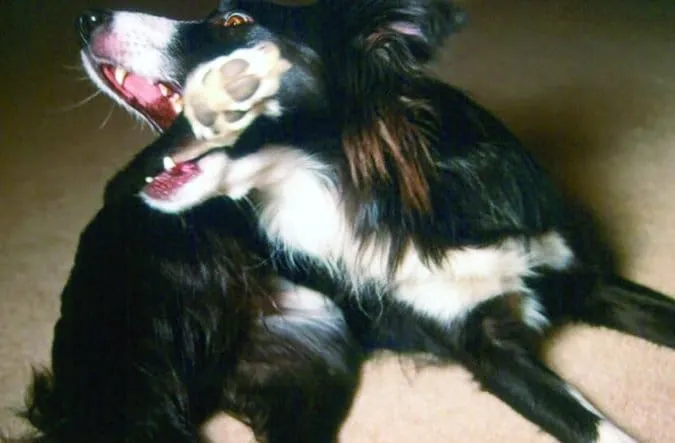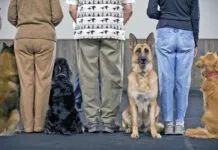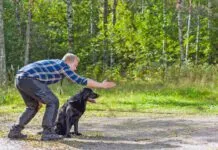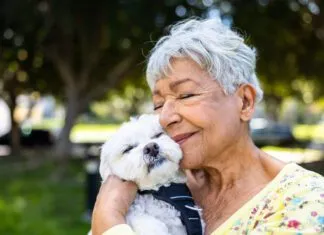Life with any dog has its moments of agony and ecstasy. The ecstasy happens when our dogs’ behaviors are top notch, and all systems seem to run smoothly. The agony happens when our dogs have an “oops” moment, and we know we’re responsible.
I’ve yet to meet a dog owner who does not have at least one embarrassing story to share, of an unguarded moment in time, when in a public place, his or her dog acted in a socially inappropriate way.
Part of learning is making mistakes, and as trainers or companion dog owners, we learn to survive those “oops” moments. But that doesn’t mean there aren’t times when we wish we could don a cloak of invisibility.

As a now-retired service dog trainer, I’ve spent countless field trips teaching my dogs to work comfortably and reliably in public environments. We teach service dogs to respond appropriately in places where pets are not allowed; obviously, we also teach them to display appropriate behaviors in public places as well. Our wonderful canine companions help us with many tasks as we accomplish our errands and work, but they must also behave appropriately during our leisure actitivities in public, such as when we meet a friend for a cup of coffee at an outdoor café, attend an art festival, or enjoy a festive picnic in a park.
It happens when we least expect it: Our dog is standing quietly by our side on a loose leash, ignoring distractions, when he suddenly unloads his bladder while waiting at a crosswalk for a light to change, splattering shoes of other people also waiting to cross the street.
We might be browsing items in a booth at an outdoor art festival with our dog standing or sitting quietly at our side, and our attention is drawn away from our dog for a moment. In the single second we take our eyes off our dog, he swivels his head and sticks his nose into another shopper’s crotch, inhaling dreamily. Though we instantly cue the dog to focus on us again, it’s too late. The crotch sniffer has already goosed his gander.
We may have thought we’d adequately prepared for these kinds of responses by allowing our dog ample time to “empty out” before going into stimulus-rich environments, and we may have practiced “leave it” in as many diverse environments as possible. But sometimes, especially with young, more easily distracted dogs, the occasional “oops” will inevitably happen when we least expect it.
It’s Not a Criticism, Just Information
I chalk these moments up to “learning experiences” for the trainer/handler, and see it as simply helpful “information” – a hint that we need to be more vigilant and proactive during future training outings. It’s also a chance to suck up our embarrassment, and learn to laugh through the red-faced moments. We learn along with our dogs – our greatest teachers.
When I was a novice service-dog trainer/handler, my first service dog was a 10-pound Papillon named Peek. He was nearing the end of his first year of training, well on the way to becoming a very reliable service dog, and was generally extremely well mannered in public. I knew the first rule of public access-training was to never take your eye off your dog for very long, and to always be aware of your dog’s body at any given time.
Peek was becoming so reliable in stores, never sniffing nor soliciting attention from other shoppers, that I began to relax my guard a bit; honestly, I became somewhat complacent. Inside a craft store, I focused more on the craft items I wanted to buy that day, and too little on the fact that my dog was still learning lessons in appropriate public behaviors.
Stopping at one aisle for a few minutes, I lost my focus on my dog, gathering items to put in my lap basket as I rolled through the store in my wheelchair. I’d occasionally glance down at my dog, but he remained nicely in a heel position, so I kept shopping. Finding my last item, I headed to the cashier’s counter and put my items on the conveyer belt. When the cashier had scanned all the items in my lap basket, she paused, smiled, and said, “I’m just waiting for your last item, ma’am.”
I looked down at my lap, thinking perhaps something had come out of my basket and was between my legs or stuck between my leg and the seat of the chair, but I saw nothing. I looked back up at the cashier in bafflement. She whispered, “Your service dog is carrying your last item, ma’am.”
Knowing I hadn’t asked him to hold anything, I looked down, this time looking at his head, not just seeing that his body was parallel to the wheels of my power chair. I didn’t notice that though he had stayed in perfect heel position, he had a death grip on a white rabbit pelt, which he’d somehow pilfered off a bottom shelf when I wasn’t paying attention. It was now clamped securely between his chops, dripping with ropy drool.
Horribly embarrassed, I tried to cover by saying, “Oh, I’m so very sorry – I completely forgot about that item.” I cued Peek to release the item into my hand. Peek released the item to me, and never moved, but he drilled a hole through that rabbit pelt with his eyes, willing it back into his mouth.
Holding the pelt by two fingers, I try to wipe it off with a couple of wadded-up tissues, but it was hopeless. That ropy, sticky drool was embedded in the thick white rabbit pelt. The cashier looked at the dripping pelt, grimaced, and said, “That’s okay, ma’am. You just read the numbers to me and I’ll key it in manually instead of scanning it.” No way was she touching that slimy object.
It was a sobering moment to realize my inattention had allowed my dog to shoplift an item from a store. Yes, it was back to “Dog Zen” and refining the dog’s ability to bypass the urge to sniff and pilfer items he had not been asked to carry.
Beware the Rewarding Environment
Another time, when I lived in the Sonoran desert, I had a 6-month-old puppy named “Dandy,” a young service-dog hopeful. For desert dogs, water is an excellent primary reinforcer. After a nice down-stay or a sit, a cupful of water is a most coveted reward. Dandy, however, was a duck-in-training. Papillon by birth, he seemed to be more waterfowl or fish by nature.
On our river walk that day, the green Palo Verde trees on the newly landscaped path were being watered by effluent -recycled water used for irrigation. It’s common in the desert for landscapers to dig moats around the trees for the water to pool up and gradually soak into the hard, desert sand and clay soil.
Young Dandy trotted along next to my wheelchair on a loose long leash, as it was a relaxing “sniff and jog” trip, and he’d stop every few bushes to hike a leg and post a pee-mail message.
Suddenly, Dandy darted to the left, pulling the long leash loose from my hands as he spotted the irrigation sprinklers pop up and spurt fountains of water up into the air around a tree.
Before I could get “Dandy, COME!” out of my mouth, he’d jumped into the water, and started swimming around the tree, wrapping the leash twice around the thin tree trunk. Dandy looked up, shook off (standing in water that was over his belly), and tried to move toward me, but he could only walk a few steps before the securely wrapped leash stopped him.
He began swimming back and forth, paddling water, ducking his head, lifting it out of the water, shaking his head and diving his head back under the water again. He looked like a mallard duck in training.
I realized I had no choice but to slide out of my wheelchair and crawl across the dirt and cacti, into the moat of muddy water, to untangle his leash. I crawled from my chair to the water’s edge, and slid into the waist-deep effluent and attempted to untangle the leash.
Happy for a playmate, Dandy snapped at the fountains of water coming out of the irrigation tubes, then rolled over, submerging his body, and leapt up like a dolphin to grab another sip, vaulting over the top of the rubber tube. Clearly, this was the best water park he’d ever seen.
Dandy was happily barking at the spurting water as I laughed heartily while unclipping the leash from the top of his harness. I giggled out the recall cue and Dandy swam toward me, glad to be unfettered. Reaching me, he climbed up onto my lap, leapt over my shoulder and dove back into the water.

We splashed each other with water until we were both covered with mud, and I have to admit that on that 100 degree day, it felt mighty refreshing.
A lone, perspiring jogger dashed by, tipped his baseball cap at us, and quipped, “Nice day for a swim, isn’t it?”
New Behaviors
I had a lovely Border Collie named Finn, a change-of-career dog. He was a gift from Virginia (Broitman) Dare, after I lost my service dog Peek prematurely from congestive heart failure. Virginia thought that all Finn’s past media work for print and video could easily transfer over to service work with just a bit of tweaking to turn a trick into a task.
Finn was used to crowds, noisy equipment, bright lights, and lots of people scurrying around. Nothing much fazed him.
When Virginia delivered him to me, we went for a training outing at a local casino here in Las Vegas. Finn flawlessly pressed handicapped door openers, picked up trash and put it in the trash bins, did nice sits and downs for extended periods, and ignored all the distracting food treats we’d thrown on the floor to test him.
I’d spent a decade using a different set of cue words and phrases for my own service dog. Virginia wrote down as many words and phrases she could think of that were already in his repertoire, admitting she could not remember them all. I cued Finn to pick up his leash, accidentally using my own default cue phrase of “Get your leash.” Finn’s cue for that behavior was “Take it.” Finn had never heard my particular cue words coupled together, but he knew “Get your. . . .” And he filled in the blank with a behavior he thought I might have meant.
He reached back, picked up his left rear leg, and held it in his mouth. Virginia and I broke out in laughter at my miscued directive, and we couldn’t stop laughing while Finn stood there holding his left leg in his mouth. He remembered a behavior he’d once been taught years prior, of “get your leg.”
In moments, a crowd had gathered, watching in amazement as this dog stood there holding his back leg and beckoning us with his eyes for the release cue. New handler error! And of course, there was a nice reward for the problem-solving dog who had no fear of trying new behaviors, as he’d been shaped regularly to think up compound cues and adduction.
As trainers, handlers or companion-dog owners, we all have experienced those moments of enjoying the ecstasy and enduring the agony. But it’s also a journey filled with unexpected mirth and great lessons, which makes every outing fresh and original.
Debi Davis is a retired professional calligrapher and service dog trainer. She is a former faculty member of Clicker Expo, and has presented at service dog training seminars and workshops. Peek, her first service dog, was a 1999 National Service Dog of the Year and participated in animal assisted therapy in a hospital rehabilitation department. Davis and Peek carried the Olympic torch during the Salt Lake City Games. Debi is an advocate for reward-based training, and enjoys being an informal ambassador of goodwill in the service dog and disability communities. She currently lives in Las Vegas, NV, with her husband and service dog in training, Cooper.








